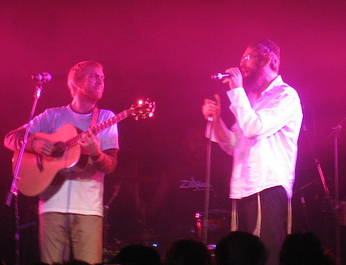Saturday night I did what I do most of my Saturday nights: went to hear some music. Tonight was also the fifth of the those eight crazy nights of Hanukkah, and I wound up at a Matisyahu show, w/my husband and some friends, at Warsaw, aka the Polish National Home, in Williamsburg, Brooklyn.
Matisyahu is a young guy from White Plains, who formerly followed Phish around the country. Now he’s an observant Jew, a Hasid, and a successful musician who mixes rap with reggae and a bit of Hebrew. He lives in Brooklyn, right in the middle of the Hasidic community, which is right next to one of the largest West Indian communities in the country, in this particular One City.

What a glorious culture mashup it was. The energy was great; the crowd was wild. Matisyahu came out in full Orthodox garb, with white shirt, black suit, tzitzit (fringes), hat and even a cane (had he injured himself w/his exuberant onstage antics?), but half an hour into the near two-hour show, the jacket was gone, the shirt was loose, and the drummer and percussionist were going crazy, as Matisyahu rapped, paused for some searing guitar solos that would not have been out of place at a Bon Jovi show. Trevor Hall (above) joined him for an introspective Jack Johnson-esque piece; two young male “backup dancers” came out in suits and hats and tore up the place with some mighty rave-y moves.
Yet more than a few people wonder about the “legitimacy” of this suburban Jewish kid playing reggae and wearing Hasidic garb. Is it just schtick? Inappropriate cultural appropriation? Who appropriated what first, and is “appropriation” even a helpful word?
I sure don’t have the answers, or the sociological chops to argue one way or the other. But a look at some of the influences that created the night is quite a foray into the interdependence of global cultural production.
There’s that weird Jewish-reggae thing. The Star of David, the Lion of Judah, references to Exodus — such totally Jewish symbols abound in Rastafarianism and reggae. That common vocabulary is what makes it perfectly normal that my brother-in-law plays Bob Marley’s Exodus every Passover. But why, exactly, is this so?
Interdependence again. Last year I saw an excellent documentary called Awake, Zion! which revealed that others have wondered as well. Others who were in film school, who dedicated years of their life to finding out — i.e., the moviemaker. She traces a fascinating journey from Jamaica, to Ethiopia, and around the world; finally locating the connection in an ancient legend about the Queen of Sheba, King Solomon, and the ancestry of Haile Selassie. So that’s where Rastas got the Star of David and the Lion of Judah. Ahh.
Rastafarians draw on an Old Testament heritage. A young Hasid draws on reggae. Jamaican musicians drew on American R&B beats and added their own rhymes to best each other in soundsystem battles. Jamaican DJs brought the soundsystem style to the Bronx in the 1970s and turned “toasting” lyrics over beats into rap and hip-hop.
And Saturday night at the Polish National Home, rap, reggae, and the Old Testament all came together in a sweaty joyful celebration, as behatted and suited dancers rocked out next to tank-top-wearing mosh dudes, jumping ecstatically to umistakable reggae riddims and everything bounced back and forth: the influences and crowd’s collective booty both.
Appropriation aschmopriation. It’s not just shopping in the cultural supermarket, trying on what fits. Connections resonate on deeper levels. A friend of mine runs a rather wild call-in radio show — http://www.blogtalkradio.com/igotmyreasons — and one recent topic was titled “GLOW-BALL: International Youth Culture.” He examined political rap from its start in the U.S.A. back in the day to today’s Africa, where a young Somali makes hip-hop hits telling warlords to stop running guns and young Senegalese have made rap their own, using their power as a musical presence to affect elections and call out the vote in ways unheard of in the United States. Some tunes mix modern African rhythms with Fela Kuti-style horns, which drew from 1970s James Brown, the sounds bouncing back and forth across decades of trans-Atlantic influence. Nobody seems to worry much who borrowed what.
And in the bar off to the side, Polish ladies sold pierogies and blintzes to the danced-dazed descendants of Eastern European Jews who had fled Poland’s pogroms generations before. It’s my husband’s heritage; he considers pierogies Jewish soul food, just as much as the Poles consider it a national dish. And the irony of all this Hanukkah happening in a spot called Warsaw was not lost on him.
In the microcosm of the Polish National Home was reflected the interdependence that lights up One City. As the chandelier in the hall spun like a disco ball, it looked pretty clear that the music was a mirror glow-ball reflecting and refracting visible light and audible beat: Globally, interdependently. Joyously.
And after a rousing encore, the lights came up, the PA went on . . . and the crowd flowed out into the Brooklyn night, lustily singing along to Journey’s “Don’t Stop Believing,” blasting over the loudspeakers. Hey, everybody saw The Sopranos ending, I guess.
